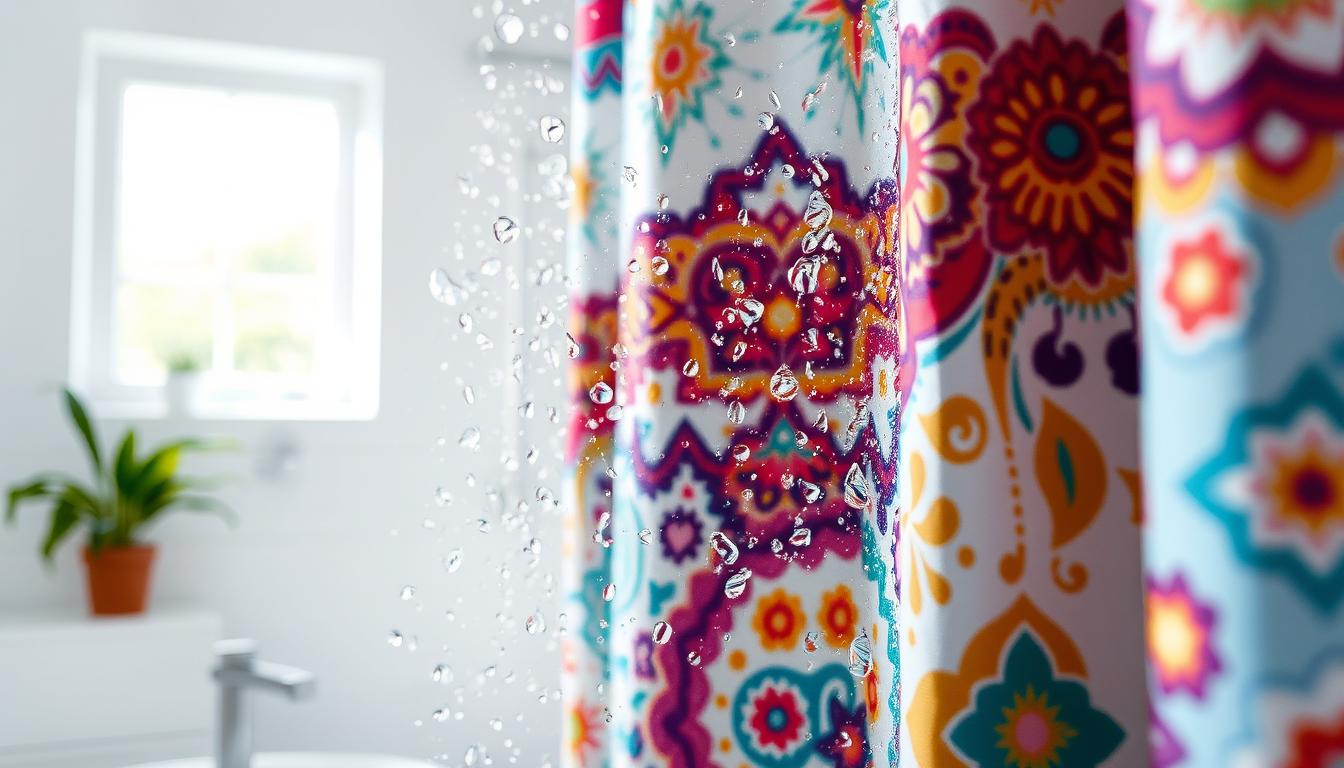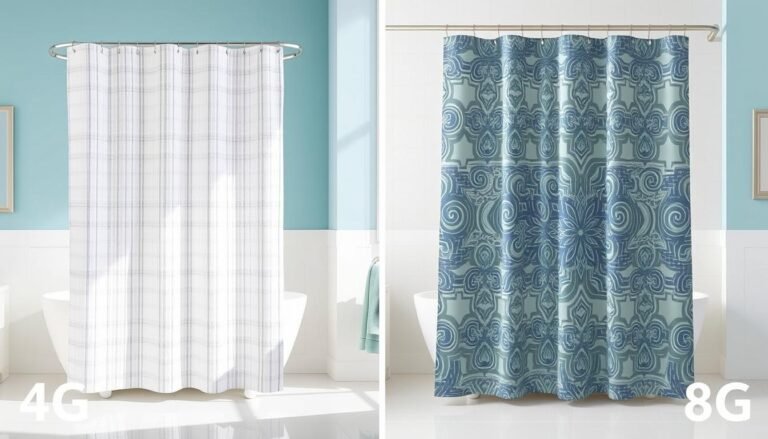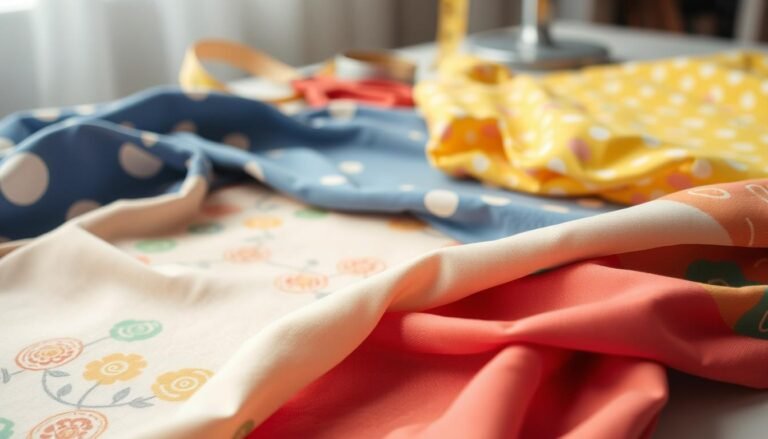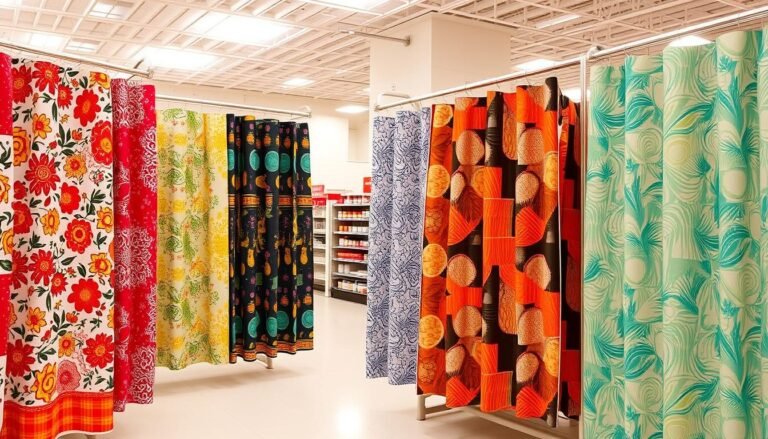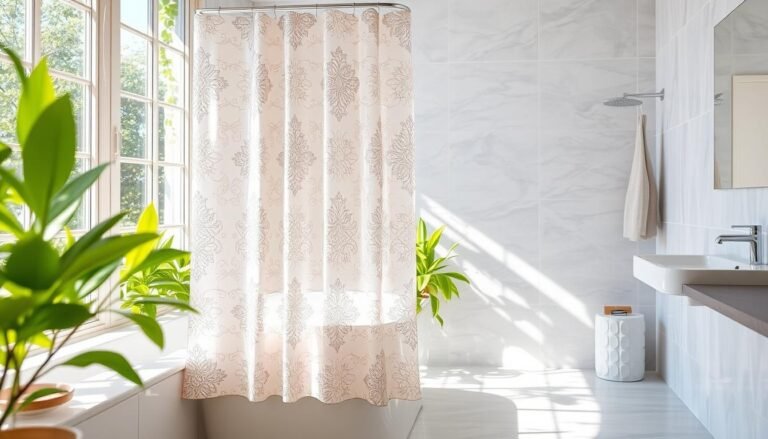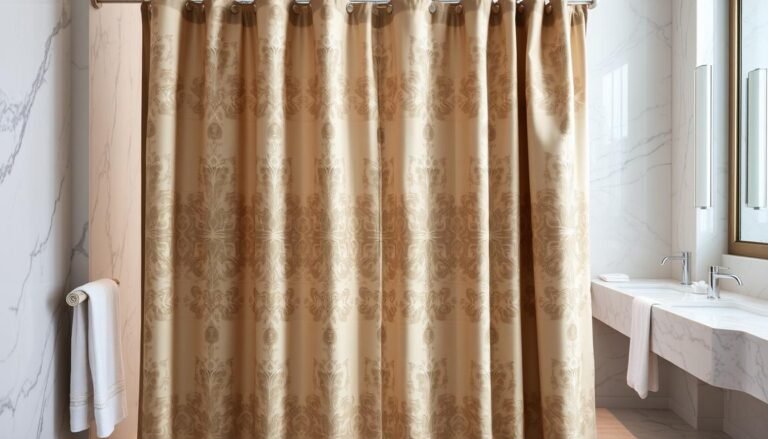Can Fabric Shower Curtains Get Wet? Know the Facts
Are you thinking about changing from plastic to fabric shower curtains? You might question if they can handle being wet. In a small, old bathroom without windows, using a linen curtain instead of plastic was a good choice. The linen soaked up water well, preventing any mess and dried out fast. We also changed how the shower head worked and moved the curtain to help it stay clean.
To keep away mold and mildew, we started doing a few things. We made sure to stretch out the curtain to dry, used a ceiling fan, and kept the door open after showers. These steps are also in the fabric shower curtain care instructions. By following these methods, fabric curtains can be both eco-friendly and simple to keep clean. Adding these actions to your routine can keep your bathroom looking nice. It also makes the move away from plastic easier.
Understanding Fabric Shower Curtains: What Materials are They Made Of?
The materials used in fabric shower curtains are vital. They affect how you use, clean, and how eco-friendly they are. Knowing about the fabrics helps you pick the best one for your needs.
Common Fabrics Used in Shower Curtains
Fabric shower curtains are made from both organic and synthetic fibers. Each type has its pros and cons. What’s best for you depends on what you value most, like safety, easy care, or being good for the planet.
Organic Options: Cotton, Linen, and Hemp
For those looking for safe and green options, cotton, linen, and hemp are great.
- Cotton & Linen Shower Curtains: These come in many styles and give a touch of luxury. But they can attract mold and mildew if not looked after well.
- Hemp Shower Curtains: Hemp is durable and fights off mildew and germs. It’s green, but it needs to be washed often. It absorbs water and can break down if it stays wet.
Synthetic Choices: Polyester and PEVA
Synthetics like polyester and PEVA are practical and can save you money compared to natural options.
- Polyester Fabric Shower Curtains: These offer lots of choices in colors and patterns, are easy on the wallet, and waterproof. They’re quick to dry and resist mildew, so they’re easy to keep up.
- PEVA Shower Curtains: PEVA, a safe and recyclable fabric, is a good pick instead of usual plastic. It helps keep away mold and mildew. For the best results, replace it now and then.
Can Fabric Shower Curtains Get Wet and Stay Functional?
Yes, fabric shower curtains can handle getting wet. The secret is in selecting the right fabric.
High-quality cotton or polyester blends are great. They deal with moisture well. Our tests of 48 curtains showed the best were made from top materials.
Keeping your curtain in shape involves a few steps. Use a bathroom fan or keep the door open. This helps keep moisture away. Making small changes like controlling spray helps too.
We tested curtains by washing and drying them twice. We measured them and checked for any shrinkage. Our findings? Regular cleaning and using a liner make them last longer. A water-resistant curtain also helps.
Experts from New York City’s Department of Sanitation shared their thoughts. They emphasized proper disposal to protect our planet. They recommend polyester curtains for their durability and quick drying.
Water-resistant curtains are easier to maintain. It’s important to follow care tips and use a liner for extra protection. For more tips on maintaining home items, check this resource.
In short, the right fabric shower curtains do well even when wet. They stay functional and bring style to your bathroom.
The Benefits and Drawbacks of Fabric Shower Curtains
Choosing the right shower curtain is key for your bathroom’s look and feel. It’s important to compare fabric vs plastic shower curtains. Both have their pros and cons.
Environmental Benefits
Fabric shower curtains are better for the environment. Plastic curtains contain PVC which releases harmful chemicals. These chemicals, like phthalates and VOCs, can cause health problems such as headaches and nausea.
Opting for fabric made from organic materials like cotton, linen, or hemp is even better. These materials are biodegradable and don’t harm the planet.
Cost and Maintenance Considerations
Fabric shower curtains might cost more at first, but they save money over time. They are easy to clean and can be used again. Unlike plastic curtains, you don’t have to replace fabric curtains often.
To keep them clean, use a ceiling fan, keep the door open, and stretch the curtain after use. These simple steps help the curtain stay fresh and make it a smart financial choice in the long run.
Water Resistance and Durability
The water resistance of fabric shower curtains is a major plus. Materials like polyester and hemp dry quickly and resist water well. Polyester, for instance, pushes water away, minimizing mold and mildew risk.
Hemp dries quickly, too, making it less prone to water damage. Placing your shower head correctly and managing water flow extends the life of these curtains. This makes them more durable than their plastic counterparts.
- Environmental Impact: Reduces exposure to toxic chemicals.
- Cost-Efficiency: Long-term usability and easy maintenance.
- Water Resistance: Superior performance with materials like polyester and hemp.
| Comparison | Fabric Shower Curtains | Plastic Shower Curtains |
|---|---|---|
| Environmental Safety | High, with non-toxic materials | Low, due to toxic chemicals |
| Initial Cost | Higher | Lower |
| Maintenance | Easy to wash and reuse | Often needs replacement |
| Water Resistance | Good, especially polyester and hemp | Varies, typically water-repellent |
In conclusion, choosing fabric shower curtains is wise. They offer benefits like cost savings, fewer environmental impacts, and better water resistance. Fabric curtains are a great choice over plastic.
How to Properly Care for Your Fabric Shower Curtain
Keeping your fabric shower curtain in tip-top shape is easy with the right care. By using the proper cleaning methods, you can avoid mold, mildew, and soap scum. This will keep your curtain looking new.
Washing Techniques
It’s simple to wash fabric shower curtains in the machine. They should be washed monthly. Use a gentle cycle with warm or cool water and a bit of detergent. A quarter cup of vinegar in the rinse can cut down on soap scum.
If your curtain needs extra cleaning, soak it in warm soapy water first. Then, wash it as usual. You can dry it on low heat if the label says that’s OK.
Preventing Mold and Mildew
Keeping your bathroom airy helps stop mold and mildew. Stretch out the curtain after you shower to let it dry. Running an exhaust fan helps too. A quick spray with a shower cleaner keeps buildup away.
For mold spots, mix hydrogen peroxide with baking soda. It works great.
Using Liners for Added Protection
Add a fabric liner for extra defense against water. It also makes your curtain last longer. You can wash liners just like the curtain to keep them fresh. Coating your curtain with wax boosts water resistance. This tip helps in damp bathrooms.
These tips for caring for your fabric shower ensure a clean, fresh bathroom.
Fabric Shower Curtains vs Plastic Shower Curtains
When comparing fabric and plastic shower curtains, a few key points matter. Health concerns and easy care play big roles. Fabric is often chosen for being eco-friendly and looking good. They don’t have PVC like plastic ones do. PVC can release harmful VOCs, posing health risks over time. Plus, fabric curtains can be washed and resist mildew, making them nice for your bathroom look.
Plastic curtains, however, are praised for needing less care and resisting water well. Items like the Gorilla Grip liner are chosen for their toughness and good price. They’re made of EVA, a better choice than PVC, pleasing many looking for an easy-to-handle curtain. The Hookless Escape and Quiet Town Sun liners also use EVA. This means they’re good at stopping water and simple to clean.
But fabric curtains can get mildew or mold if not kept up well. To keep them good as new, wash them often and let them dry after showers. A quick test with a spray bottle helps you see which side should face the tub. Most agree it’s key for the curtain to drain well. Choosing a curtain that fights mildew also helps avoid these issues.
Even with the need for more care, many pick fabric curtains for their green and health perks. To see what others think about fabric versus plastic curtains, check out discussions on 2PeasRefugees. This ongoing talk shows that fabric is the choice for those valuing sustainability and wellbeing over convenience.

Hey there, I’m Alex Hanson and I’m passionate about all things covers! Whether you’re looking for a car seat cover to protect your vehicle or an oven cover to keep your kitchen clean, I’m here to help. With years of experience in the industry, I have plenty of knowledge and insights to share with my readers. So, if you care about protecting your belongings and making them look their best, you’re encouraged to read my blog as I explore the perfect cover for every need.

